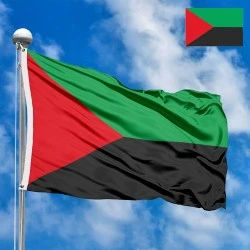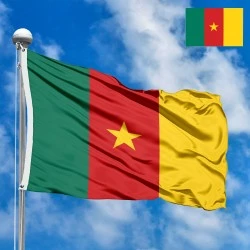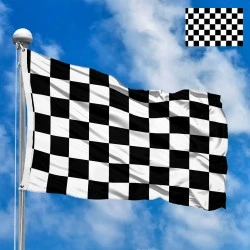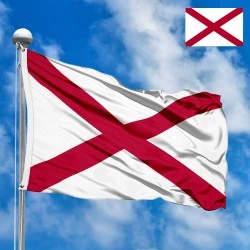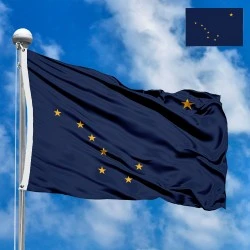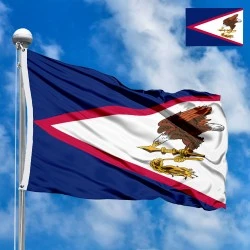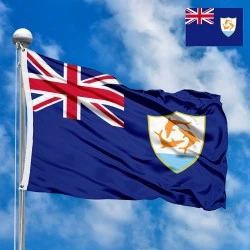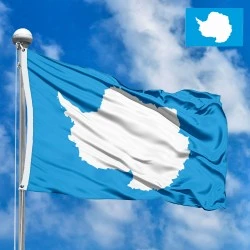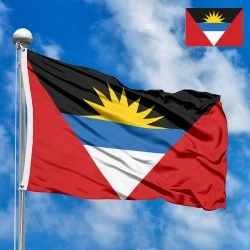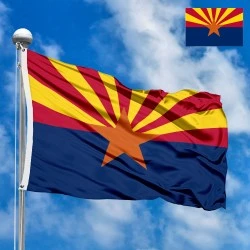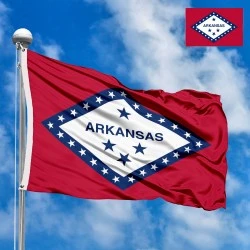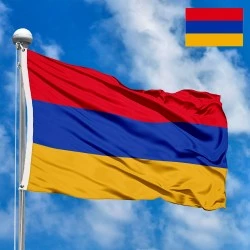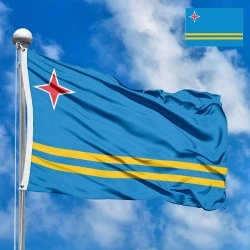- All Flags
- Flags of Countries by Continent
-
Flags of Organizations
- Flags of UN countries
- Flags of the European Union countries
- Flags of NATO countries
- Flags of the countries of the Organization of Islamic Cooperation
- Flags of the countries of the Organization of American States
- Flags of the Arab League countries
- Flags of the African Union countries
- Flags of the countries of the Union of South American Nations
- Flags of the Commonwealth of Nations
- Flags of the countries of the Secretariat of the Pacific Community
- Flags of the Nordic Council countries
- Flags of the Caribbean Community
- Flags of the countries of the Association of Southeast Asian Nations
- Flags of the East African Community
- Flags of the countries of the Organization of Turkic States
- LGBT Community Flags
- Historical Flags
- Ethnic Flags
- Flags of the USA (states)
Description
The flag commonly known as the "Snake Flag" or drapeau aux serpents served as a historical symbol of Martinique for over two centuries, from its creation in 1766 until its official replacement in 2023. This banner, deeply rooted in the island’s colonial past, represents a complex and controversial chapter in its history. While it was long considered a de facto local symbol, its association with the era of slavery and French colonialism led to its eventual rejection by a majority of the population in favor of a new, more inclusive regional emblem. Understanding this flag is essential to comprehending the long and often painful journey of Martinique's cultural and political identity.
Design and Symbolism: A Colonial Legacy
The design of the "Snake Flag" is a modification of a French naval ensign. It consists of a blue field with a white cross that divides the flag into four equal quadrants. In each of these quadrants, a white, stylized snake is depicted.
-
The White Cross on a Blue Field: This core design element is a direct adaptation of the French Navy's standard ensign of the 18th century. The blue and white colors are traditional heraldic colors associated with the French monarchy and navy.
-
The Snakes: The most distinctive and controversial element of the flag are the four white snakes. They are a stylized representation of the venomous "Fer-de-Lance" pit viper (Bothrops lanceolatus), a snake species endemic to Martinique. Each snake is coiled in the shape of a capital letter 'L' and faces inwards towards the center of the flag. This 'L' shape is often interpreted as a reference to "Lucie," an old, colonial name for the island, though some historians suggest it may have been a reference to the French King Louis XVI. The snakes were added to distinguish ships and fortifications of the French colonies of Martinique and Saint Lucia from those in France itself.
History and Origins: Rooted in the Colonial Era
The flag was officially created by a decree from the French government in 1766 for the French colonial fleet in the Lesser Antilles. It was intended to serve as a distinctive ensign for ships sailing from the colonies of Martinique and neighboring Saint Lucia. At the time, these colonies were key hubs of the transatlantic slave trade and plantation economy.
For centuries, this flag was a ubiquitous symbol of Martinican administration and, for some, a representation of the island itself. However, as the island's population began to define its own identity and grapple with the painful legacy of its past, the flag's symbolism became increasingly contested. Its direct connection to the colonial administration and the plantation system, built on the suffering of enslaved people, made it a symbol of oppression for many.
Controversy and Its End: The Call for Change
In the late 20th and early 21st centuries, the "Snake Flag" became a focal point of public debate. For independence movements and cultural revivalists, it was a painful reminder of a past that needed to be shed. Its use was increasingly seen as a sign of an outdated colonial mindset. The flag was never officially adopted by the local government of Martinique as a regional emblem, and its use became less frequent over time.
The end of the flag's symbolic era came with the historic vote and official adoption of a new regional flag in 2023. The new flag, with its red, green, and black colours, was a deliberate choice to replace the colonial symbol with one that more accurately reflected the island’s post-colonial identity, its African heritage, and its aspirations for the future. The "Snake Flag" is now considered a historical artifact, a symbol of a bygone era.
Interesting Facts
-
Not an Official Regional Flag: Despite its long use, the "Snake Flag" was never officially adopted as the regional flag of Martinique by the local government. It was primarily a historical naval and administrative ensign.
-
A Shared History: The same flag design, including the 'L'-shaped snakes, was also used for the neighboring French colony of Saint Lucia, highlighting their shared colonial history before Saint Lucia gained independence.
-
Symbol of Controversy: The flag is a frequent subject of heated debate on the island, particularly on social media and in political discourse. Its use is now often met with criticism and is seen as insensitive to the struggles of the ancestors of many Martinicans.
Significance for the People
For the people of Martinique today, the "Snake Flag" holds a complex and often contradictory significance. For some, it is simply a historical symbol, a reminder of the island’s past. For others, particularly those advocating for greater autonomy and self-determination, it is a painful emblem of a colonial system built on slavery and racial inequality. The decision to officially replace it with the new red, green, and black flag was a crucial step in healing historical wounds and collectively moving towards a more inclusive and self-defined identity. The "Snake Flag" now stands as a marker of the past, while the new flag charts the course for the future.
In the demonstration images, full-size flags are shown with proportions of 2:3, and hand-held flags with proportions of 1:2.
Donation
Download
Completely free for commercial and non-commercial use (public domain).
You can freely use them in your news magazines, websites, software, mobile applications.
We appreciate a backlink to https://flagssite.com
Raster files - Flag of Martinique (1766–2023) (PNG, JPG)
 Waving flag
Waving flag
- PNG format (transparent background), 72dpi, dimensions in Pixels (px), aspect ratio 3:4.
- 15х20 px
- 30х40 px
- 60х80 px
- 120x160 px
- 240x320 px
 Sizes:
Sizes:
"v15" - image size (by height); if necessary, replace with available: v15, v30, v60, v120, v240.
!!! For resizing, use the Latin (eng) keyboard layout.
<img src="https://flagssite.com/flags/v15/20529.png" alt="Flag of Martinique (1766–2023)">
 Round flag
Round flag
- PNG format (transparent background), 72dpi, dimensions in Pixels (px), aspect ratio 1:1.
"d15" - image size (diameter); if necessary, replace with available: d15, d30, d60, d120, d240.
!!! For resizing, use the Latin (eng) keyboard layout.
<img src="https://flagssite.com/flags/d15/20529.png" alt="Flag of Martinique (1766–2023)">
 Rectangular flag 2:3
Rectangular flag 2:3
- JPG format, 72dpi, dimensions in Pixels (px), aspect ratio 2:3.
"h30" - image size (by height); if necessary, replace with available: h15, h30, h60, h120, h240, h360, h480.
!!! For resizing, use the Latin (eng) keyboard layout.
<img src="https://flagssite.com/flags/h30/20529.jpg" alt="Flag of Martinique (1766–2023)">


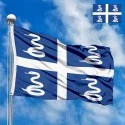

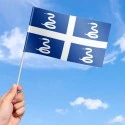




 Sizes:
Sizes:
 Sizes:
Sizes:
